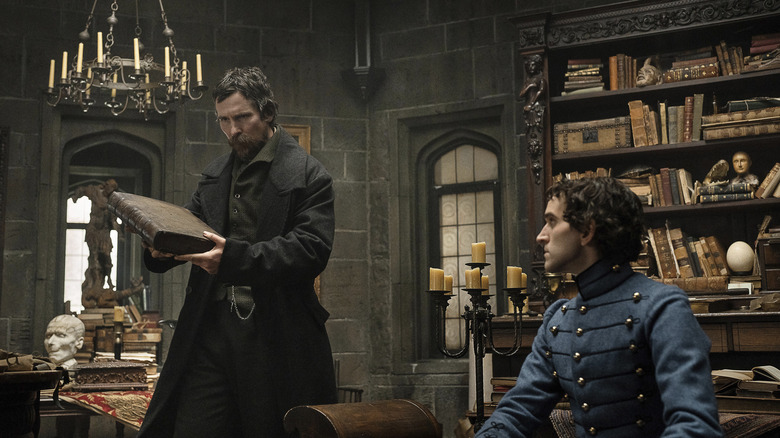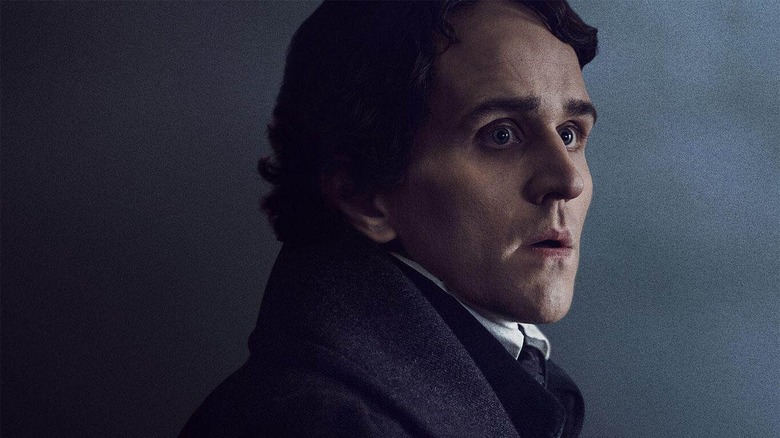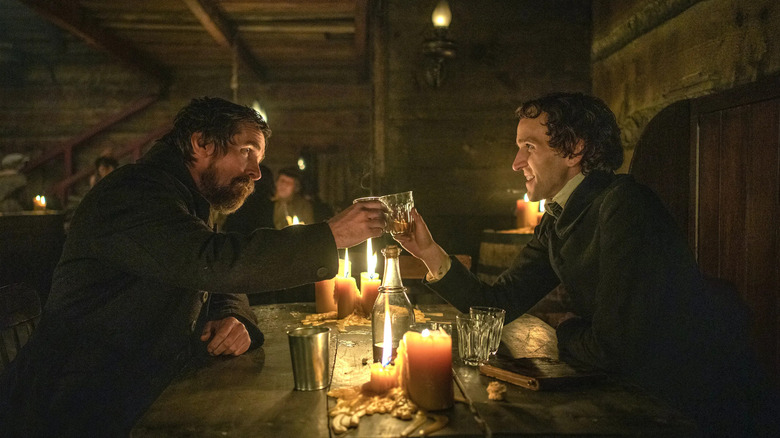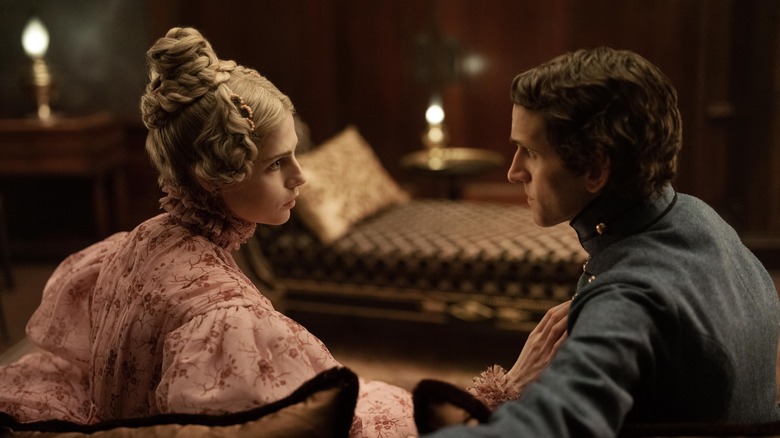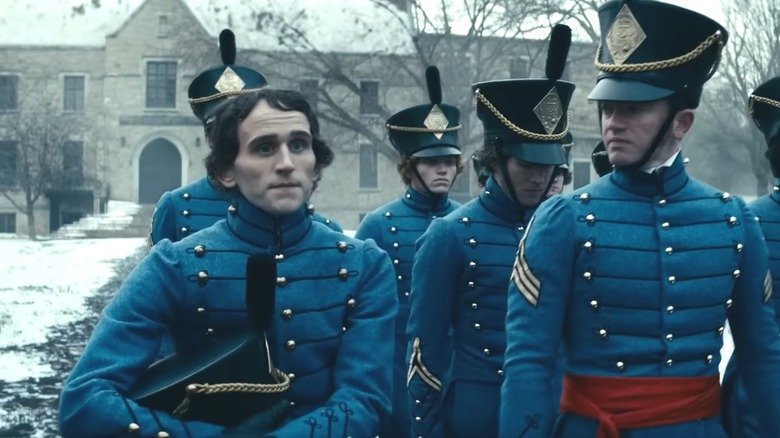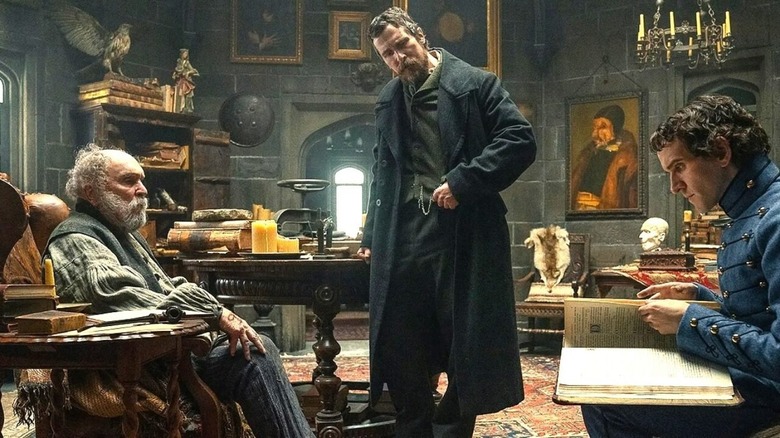How Much Of The Pale Blue Eye Is Based On A True Story?
Few literary figures have achieved the same kind of pop culture afterlife as Edgar Allan Poe. Much like Franz Kafka, the idea of Poe has become conflated with the writer's most famous works: The tragic, haunted figure, scribbling away feverishly by candlelight, only pausing occasionally to fling open the shutters of his window and gaze out into the night beyond with fear and trepidation.
This romantic notion makes Poe an intriguing character who has carried well into other mediums. There are hundreds of comics based on the author and/or his works (even teaming up with the Dark Knight in "Batman: Nevermore"), as well as stage plays, radio shows, books, and, of course, movies. The controversial master of silent cinema, D.W. Griffith, directed the first film based on the author, "Edgar Allan Poe," back in 1909, and actors including Joseph Cotton, Klaus Kinski, and Ben Chaplin have all played the gloomy author on screen. There are dozens of films related to his works, perhaps the most memorable being Roger Corman's string of gaudy adaptations with Vincent Price in the '60s.
While Poe may be best remembered for his gothic horror, he is also regarded as the father of modern detective fiction thanks to "The Murders in the Rue Morgue." With this in mind, it is little wonder that some fictional versions of the author are also sleuths. In 2012 there was "The Raven," starring John Cusack as Poe on the trail of a serial killer, and last year we had "The Pale Blue Eye," with Harry Melling playing a young version of the writer helping Christian Bale's grizzled detective unravel a grisly murder mystery. But how much of the latter was based on real life?
So what happens in The Pale Blue Eye again?
In the winter of 1830, grieving former police constable Augustus Landor (Christian Bale) is summoned to the West Point Military Academy to investigate the chilling murder of a cadet. The young man was found hanged from a tree with his heart cut out, and the stuffed shirts in charge want the matter resolved with the utmost discretion. Landor immediately ruffles feathers by questioning the thoroughness of Dr. Daniel Marquis (Toby Jones), the respected physician who originally performed an autopsy on the victim, discovering a fragment of a note in the dead man's hand.
As Landor begins his inquiries, he is approached by another cadet, Edgar Allan Poe (Harry Melling), a poet eager to share his theories with the seasoned old cop. Landor humors Poe and they form an unlikely investigative duo, discovering further clues that lead them to deduce that the victim's heart was removed as part of an occult ritual. Landor begins to suspect the strange family of Dr. Marquis, particularly his haughty son Artemis (Harry Lawtey) and ailing sister Lea (Lucy Boynton). As the mystery unfolds and another corpse is found strung up and violated, Poe falls hard for the doomed young woman.
"The Pale Blue Eye" is a ponderous whodunnit short on actual sleuthing and high on bleak atmosphere-building, stalling altogether in the second half as the detective work goes on the back burner while Poe tentatively woos Lea. It unravels altogether with a far-fetched twist; you can almost hear the film take a breath and say to itself, "Okay, here goes" before the preposterous reveal.
The saving grace is Melling's entertaining and touching performance as Poe. Not only does the English actor bear a fantastic resemblance, but he also has a twitchy earnestness and pensive intelligence that is well-suited to a fictionalized version of the author.
Poe's problems with alcohol and gambling
Director Scott Cooper has described "The Pale Blue Eye" as Edgar Allan Poe's "origin story," and the screenplay pays many nods to the author's life and work. The well-known photos of Poe were taken toward the end of his life, showing a figure ravaged by grief and booze: lopsided, pained, sodden, puffy, acrid, with a million-mile stare that speaks of his sorrow and problems with alcohol. Cooper's film is refreshing in the sense that it gives us a version of Poe before the tragedies of his life wore him down, an eloquent young man set apart from his peers at the academy by his poetic sensitivity, florid language, and courtly manners.
It is far from a biopic but it hints at aspects that would plague the real Poe's life. As the story unfolds we see Poe drinking and gambling, two addictions that shaped the circumstances of the author's life from his teens onward. As a student at the University of Virginia, he racked up heavy gambling debts which caused a huge rift between him and his foster father John Allan. They never managed to reconcile their differences and the weight of Poe's debts was a significant factor in his decision to enlist in the Army. His time as a student also started his lifelong relationship with alcohol, an addiction that grew worse after his wife, Virginia Clemm, passed away in 1847. From "The Raven" to "Ligeia," the theme of a dying young woman is a recurring one in Poe's work, so naturally "The Pale Blue Eye" also gives us a tragic romance to go along with the murder mystery element.
The tragic loves of Edgar Allan Poe
"The Pale Blue Eye" grinds to a halt when Poe becomes smitten with Lea, a troubled young woman who suffers from mysterious seizures. She isn't all that interested in him at first but he wins her over with his sensitivity and eloquence, taking her on a date to a cemetery and reciting a morbid poem from which the movie takes its title.
The poem isn't a Poe original but it directly references two of the author's works. He refers to Lea as "Lenore," the title of a poem published in 1843, thought to be Poe's way of dealing with the sickness of his wife Virginia, who passed away four years later. The actual phrase "The Pale Blue Eye" doesn't appear in "Lenore," but instead comes from "The Tell-Tale Heart," Poe's short story that has a strong thematic link to the plot of the film.
Poe's relationship with Lea is ill-fated and she seems to be a composite character based on Poe's two real-life lost loves. Firstly, there was Sarah Elmira Royster, Poe's neighbor in Richmond, Virginia, who he started courting when he was 16 and she was 15. Her father put an end to it while Poe was studying at the University of Virginia, feeling that he was an unsuitable match for his daughter. They lost touch, and Royster later married a wealthy businessman instead.
Lea may also be partly based on Poe's wife, Virginia Clemm. His first cousin was only 13 years old when they married (he was 27), and she died from tuberculosis aged only 24. Putting aside the ick factor of their ages aside, Poe was stricken with grief after her death and the loss had a powerful influence on his later work, contributing to the tragic popular figure of Poe that persists to this day.
Edgar Allan Poe in the military
The popular image of Edgar Allan Poe doesn't exactly cast him as a physical type, so it comes as a bit of a surprise in "The Pale Blue Eye" to find him as a cadet at West Point. The film portrays him as something of an oddball at the academy, but the real Poe actually had a bright future in the military. At least, to begin with.
Struggling with his gambling debts, estranged from his benefactor John Allan, and upset that his childhood sweetheart had married another man, Poe signed up for a five-year stint in the First Regiment of the Artillery in the U.S. Army. He showed immediate promise by becoming an Artificer, in charge of the battalion's munitions, a technical job that required precision and a good head for figures. Poe was well-suited to this duty, as throughout his life a keen eye for the latest scientific developments and breakthroughs, incorporating some of the latest concepts in medicine and psychology into some of his works. After two years, he rose to the rank of Sergeant Major for Artillery.
Although his military career appeared to be flourishing, Poe decided to quit the Army and seek an appointment at the U.S. Military Academy at West Point, persuading John Allan to begrudgingly help secure a spot. Unlike the outcast Poe in "The Pale Blue Eye," the aspiring writer kept his fellow cadets entertained with poems which earned him a reputation as something of a genius on campus. He also performed well in his classes but he struggled with training and discipline and lasted less than a year, getting himself court-martialled and kicked out after dropping his classes.
Did Edgar Allan Poe investigate any real-life murders?
Sadly there is nothing to suggest that Edgar Allan Poe got involved in solving real-life crimes, but he is an important figure in detective fiction thanks to "The Murders in the Rue Morgue." Modern law enforcement was still in its formative years when the story was first published in 1941, introducing a gentleman amateur sleuth called C. Auguste Dupin as he cracked the case of two women killed in a now-classic locked room scenario. Dupin used rational methods of deduction to solve the crime, paving the way for the likes of Sherlock Holmes and Hercule Poirot.
For his follow-up, Poe had a hand in true crime, too. "The Mystery of Marie Rogêt," a sequel also starring Dupin, was based on the real-life case of Mary Cecilia Rogers, a young woman who kept a New York cigar shop buzzing with male admirers before she vanished in July 1841 and was found dead in the Hudson River several days later. The coroner recorded that she may have been severely beaten prior to her death and the sensational case drew front-page attention in the press. Poe resolved to create a murder mystery around the incident, moving the facts of Rogers' unsolved murder to Paris and wrapping it up with Dupin helping the police find the killer.
Much of the pleasure of "The Pale Blue Eye" is the way Harry Melling's Poe relishes unearthing clues and making bold deductions as he assists Augustus Landor, whose first name is a neat nod to the real author's groundbreaking detective. The real-life Poe may not have done any sleuthing but his contribution to detective fiction was huge, so it's fitting that his modern fictional counterparts are getting in on the action and cracking cases of their own.
